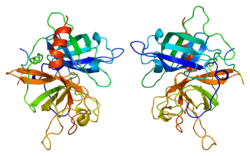Protein involved in the breakdown of blood clots
Tissue-type plasminogen activator, short name tPA, is a protein that facilitates the breakdown of blood clots. It acts as an enzyme to convert plasminogen into its active form plasmin, the major enzyme responsible for clot breakdown. It is a serine protease (EC 3.4.21.68) found on endothelial cells lining the blood vessels. Human tPA is encoded by the PLAT gene, and has a molecular weight of ~70 kDa in the single-chain form.[5]
tPA can be manufactured using recombinant biotechnology techniques, producing types of recombinant tissue plasminogen activator (rtPA) such as alteplase, reteplase, and tenecteplase. These drugs are used in clinical medicine to treat embolic or thrombotic stroke, but they are contraindicated and dangerous in cases of hemorrhagic stroke and head trauma. The antidote for tPA in case of toxicity is aminocaproic acid.





